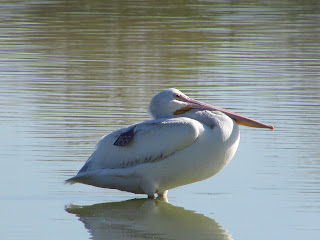I have lived in Arizona for over sixteen years and in that time I have visited the Pacific coast many times. During my visits, I typically see many pelicans. They are usually flying over the water in large groups or standing on the top of buildings resting. Where I have never seen pelicans is around my home in the Arizona desert...until recently.
I have written about wintering birds that I have found at my local riparian preserve before but on a recent trip, I saw a pelican. That feeling of seeing a new bird never gets old but seeing a pelican so out of the normal environment that I associate with pelicans made me doubt what I was seeing. This guy was not terribly close to where I was standing and was simply much bigger than other birds as I scanned the water. It wasn't until I zoomed in with my camera that I realized that this stately fellow was a pelican. Even then, I will admit that I snapped off a few photos and then looked back at my camera to triple verify what I was seeing. There really was no mistaking that this large bird that I associate with the coast was standing in a man-made pond in the Arizona desert.
As I looped around the pond, I noticed a tag on his wing which made me very excited to see if I could figure out where he came from and if possible why he was here. I have to admit that I couldn't figure out very much but I believe that he is from Idaho just based on the coloring of the tag and migrated here for the winter. I found him fascinating to watch and as I headed home I assumed that he would have moved on by the time I returned the following week.
A week later, I returned with my daughter and to my surprise not only was he still in the same pond but he now had a friend. They have discovered that Arizona has plenty of food for them and as many other winter birds already know, we have plenty of sun and warmth. They were busy eating and paddling around when we visited. It seemed as though all the other birds on the pond were completely unfazed with having such large guests to the water. The smaller birds happily went about their own floating as the pelicans fed and swam.
Nature never stops amazing me and the thrill of seeing wild animals so unexpected in my area gets me excited to continue exploring. No matter how busy my week, I try to carve out a little nature time whether it is for a hike, sitting by the lake, visiting a local park, or wandering the riparian preserve. Leaving the world behind for even a few moments can give me a new perspective and at times a new attitude for the rest of the day. Everyone needs a source of recharging in their week. For me, during the last several weeks the pelicans have been that source.




Comments